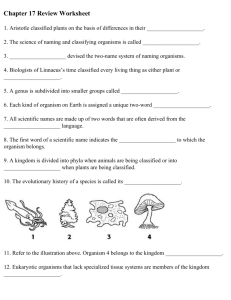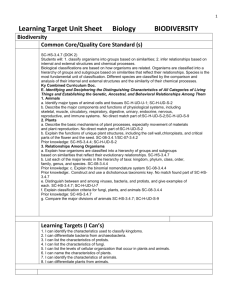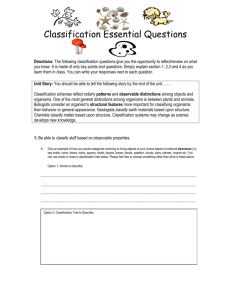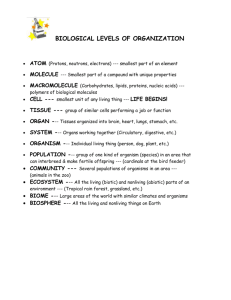Classification Test Review: Essential Questions
advertisement
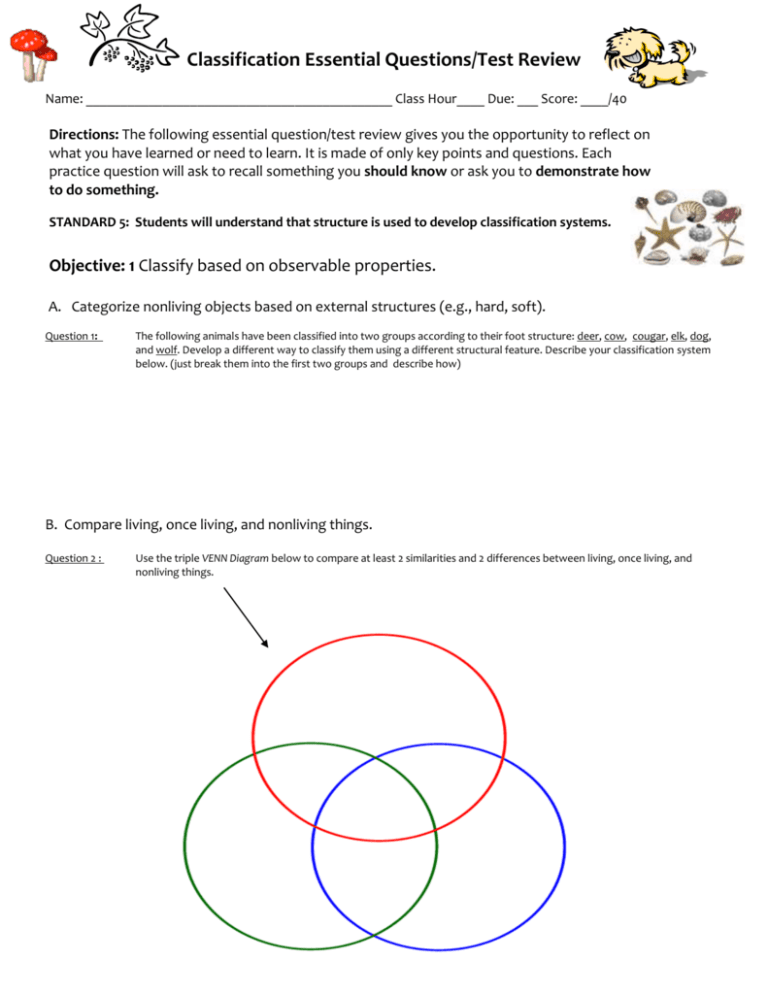
Classification Essential Questions/Test Review Name: ____________________________________________ Class Hour____ Due: ___ Score: ____/40 Directions: The following essential question/test review gives you the opportunity to reflect on what you have learned or need to learn. It is made of only key points and questions. Each practice question will ask to recall something you should know or ask you to demonstrate how to do something. STANDARD 5: Students will understand that structure is used to develop classification systems. Objective: 1 Classify based on observable properties. A. Categorize nonliving objects based on external structures (e.g., hard, soft). Question 1: The following animals have been classified into two groups according to their foot structure: deer, cow, cougar, elk, dog, and wolf. Develop a different way to classify them using a different structural feature. Describe your classification system below. (just break them into the first two groups and describe how) B. Compare living, once living, and nonliving things. Question 2 : Use the triple VENN Diagram below to compare at least 2 similarities and 2 differences between living, once living, and nonliving things. Question 3 : Why is a frog considered a living organism and a computer is not? (Hint: give six reasons) C. Defend the importance of observation in scientific classification. Question 4: Why is careful observation important in scientific classification? D. Demonstrate that there are many ways to classify things. Question 5 : You can use words or draw a classification tree below. Please feel free to choose something other than what is listed above. Option 1: Words to Describe ___________________________________________________________________________________________ ___________________________________________________________________________________________ ___________________________________________________________________________________________ ___________________________________________________________________________________________ Option 2: Classification Chart to Show/Describe. Question 6 : Three groups of students classified ten leaves found on the school ground: Group A classified the leaves based on their shape. Group B classified the leaves based on the margins (edges) of the leaves. Group C classified the leaves based on the pattern of the leaf veins. Why were all three ways of classifying the leaves correct? Question 7 : Why did every group not end up with the same classification system (chart and key) when we did the LEAF CLASSIFICATION activity. Objective 2: Use and develop a simple classification system. A. Using a provided classification scheme, classify things. Question 8: B. Develop a classification system based on observed structural characteristics. Question 9: C. Generalize rules for classification. Question 10: Name two basic rules we use to classify things today in our modern times. 1. 2. D. Relate the importance of classification systems to the development of science knowledge. Question 11: Name 4 reasons for classifying living things (hint: use your brown Classification Reading and Questions paper for help. 1. 2. 3. 4. Question 12: Scientists from many countries are meeting together to discuss the endangerment of the White Rhino. They all speak different languages. Why would a classification system be important to them? Question 13: What do scientists do when a new type of organism is discovered that does NOT fit into current classification systems? A. B. C. D. Nothing. They're many organisms that do not fit into current classification systems. Nothing. They wait until they find at least 10 new species and then make a new place in the classification system. Scientists create a new classification system and discard old classification systems. Scientists modify current classification systems to make a place for the new organism. E. Recognize that classification is a tool made by science to describe perceived patterns in nature. Question 14: In the past scientists used to classify living things into either the plant or animal kingdoms. Today it is customary to use a classification system that uses five kingdoms, and many scientists favor six. Why? Objective 3: Classify organisms using an orderly pattern based upon structure. A. Identify types of organisms that are not classified as either plant or animal. Question 15: Identify at least 5 organisms that are not classified as either plant or animal. 1. 2. 3. 4. 5. B. Arrange organisms according to kingdom (i.e., plant, animal, monera, fungi, protist). Question 16: Arrange organisms according to kingdom by writing the kingdom name of each next to the organism below. (i.e., plant, animal, eubacteria, archaebacteria, fungi, protist). You may write the 1st initial of each kingdom next to each kingdom instead of writing out the entire word. Donkey Horse Archaebacteria Daffodil Human Maple Tree Eubacteria Amoeba Hydra Salmonella E. Coli Mushroom Truffles Spider Yeast Crayfish Dandelion Mold Bird Euglena Sea Sponge Jelly Fish Rose Bush C. Use a classification key or field guide to identify organisms. Question 16 : Use the following classification key to identify the organisms below. Write the name of each next to each organism as you identify it using the dichotomous key below. Transparent = See through. The other structures you should know from class D. Report on changes in classification systems as a result of new information or technology. Question 17 : The ability to classify and name organisms has allowed scientists to communicate their findings with each other and study each other's work. Listed below are some developments that have led to our current knowledge about organisms: 1. Invention of the microscope 2. Aristotle classified all organisms as plants or animals. 3. A 5-kingdom classification system was developed. 4. DNA used to identify relationships between species. Write the correct order of the above developments. _______________________________________ What did you enjoy most about this unit (Classification)?
